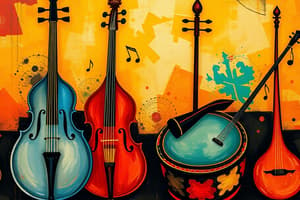Podcast
Questions and Answers
Who is the attributed author of the Nāṭya Śāstra?
Who is the attributed author of the Nāṭya Śāstra?
- Vishnu
- Shiva
- Krishna
- Bharata (correct)
When was the first complete compilation of the Nāṭya Śāstra dated to?
When was the first complete compilation of the Nāṭya Śāstra dated to?
- 300 BCE
- 700 CE
- 500 CE (correct)
- 100 BCE
How many chapters are there in the Nāṭya Śāstra?
How many chapters are there in the Nāṭya Śāstra?
- 36 (correct)
- 40
- 48
- 50
What is one of the subjects covered by the Nāṭya Śāstra treatise?
What is one of the subjects covered by the Nāṭya Śāstra treatise?
Which art forms have been influenced by the Nāṭya Śāstra?
Which art forms have been influenced by the Nāṭya Śāstra?
What is the language in which the Nāṭya Śāstra is written?
What is the language in which the Nāṭya Śāstra is written?
What is the primary goal of performance arts according to the Natyashastra?
What is the primary goal of performance arts according to the Natyashastra?
What is the concept of 'Rasa' in the Natyashastra?
What is the concept of 'Rasa' in the Natyashastra?
How does the Natyashastra view the relationship between the playwright, artists, and spectators?
How does the Natyashastra view the relationship between the playwright, artists, and spectators?
What is the significance of performance arts according to the Natyashastra?
What is the significance of performance arts according to the Natyashastra?
How does the Natyashastra view the role of innovation in performance arts?
How does the Natyashastra view the role of innovation in performance arts?
What is the purpose of the 'Rasa' theory in the context of performance arts, according to the Natyashastra?
What is the purpose of the 'Rasa' theory in the context of performance arts, according to the Natyashastra?
Flashcards
Who wrote the Natyashastra?
Who wrote the Natyashastra?
The Natyashastra, an ancient Indian treatise on performance arts, is attributed to Bharata Muni.
When was the Natyashastra compiled?
When was the Natyashastra compiled?
The first complete compilation of the Natyashastra is dated to around 500 CE, although its origins likely predate this.
How many chapters are in the Natyashastra?
How many chapters are in the Natyashastra?
The Natyashastra consists of 36 chapters, encompassing various aspects of performance arts.
What does the Natyashastra cover?
What does the Natyashastra cover?
The treatise covers a wide range of subjects, including dramatic composition, acting, dance, music, and stagecraft.
Signup and view all the flashcards
Art forms influenced by the Natyashastra
Art forms influenced by the Natyashastra
The Natyashastra has profoundly influenced dance, music, and literary traditions in India.
Signup and view all the flashcards
What language is the Natyashastra written in?
What language is the Natyashastra written in?
The Natyashastra is written in Sanskrit, the classical language of ancient India.
Signup and view all the flashcards
Primary Goal of Performance Arts?
Primary Goal of Performance Arts?
According to the Natyashastra, the primary goal of performance arts is to transport the audience to a parallel reality of wonder.
Signup and view all the flashcards
'Rasa' in the Natyashastra
'Rasa' in the Natyashastra
'Rasa' refers to the essence or emotion that a performance aims to evoke in the audience.
Signup and view all the flashcards
Relationship between Artists and Spectators
Relationship between Artists and Spectators
The Natyashastra views the relationship between playwright, artists, and spectators as intimate, where they collectively experience ultimate reality.
Signup and view all the flashcards
Significance of Performance Arts
Significance of Performance Arts
The Natyashastra considers performance arts as a form of Vedic ritual ceremony or yajna, signifying its sacred and spiritual significance.
Signup and view all the flashcards
Innovation in Performance Arts
Innovation in Performance Arts
The Natyashastra embraces innovation, allowing artists immense freedom to interpret and adapt the principles within its framework.
Signup and view all the flashcards
Purpose of 'Rasa Theory'
Purpose of 'Rasa Theory'
The 'Rasa' theory in the Natyashastra aims to empower the audience to experience the innate bliss and essence within themselves.
Signup and view all the flashcardsStudy Notes
Natya Shastra Overview
- A Sanskrit treatise on the performing arts, attributed to sage Bharata
- Dated between 200 BCE and 200 CE, with estimates ranging from 500 BCE to 500 CE
- Consists of 36 chapters with 6000 poetic verses, covering performance arts and aesthetics
Content and Structure
- Covers dramatic composition, play structure, stage construction, acting genres, body movements, makeup, costumes, and music
- Discusses the role and goals of an art director and the integration of music with art performance
Influence and Significance
- An ancient encyclopedic treatise on the arts, influencing dance, music, and literary traditions in India
- Notable for its aesthetic "Rasa" theory, which aims to transport the audience to a parallel reality, evoking wonder and spiritual/moral reflection
Etymology and Composition
- Title composed of "Nāṭya" (act, represent) and "Śhāstra" (precept, rules, manual, compendium, book, or treatise)
- Śhāstra is a suffix used in Indian literature to denote knowledge in a defined area of practice
Dramatic Arts and Aesthetics
- Natyashastra praises dramatic arts as a comprehensive aid to learning virtue, proper behavior, ethical and moral fortitude, courage, love, and adoration of the divine
- Aims to empower the audience to experience rasa, the essence or juice, through performance arts
- Rasa theory presumes bliss is intrinsic and innate in man, existing in oneself, and manifesting non-materially through spiritual and personally subjective means
Studying That Suits You
Use AI to generate personalized quizzes and flashcards to suit your learning preferences.



